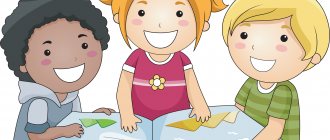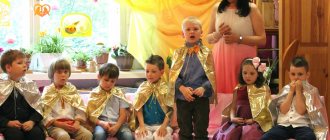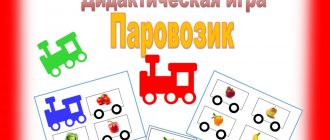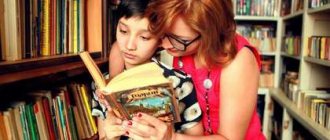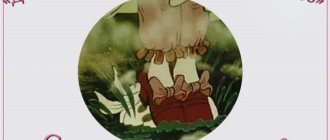Development of speech and verbal communication in children through works of fiction
Municipal budgetary preschool educational institution "Kindergarten No. 16 of Krasnoarmeysk, Saratov Region"
TEACHING COUNCIL
“Development of speech and verbal communication of children through works of fiction” Goal:
Fulfillment of the annual task: to determine the effectiveness of educational work in preschool educational institutions on the development of speech and verbal communication of children through works of fiction.
Preparation for the teachers' meeting
1. Deputy head.
according to VMR Gerasimova I.V. conduct a thematic control in the senior and preparatory groups “Organization of work to introduce children to fiction”, Preparation of a certificate based on the results of the thematic test. 2. Prepare material about illustrators and writers. – educators Savelyeva G.I. Poloneichik A.V. 3. Prepare proverbs about books and reading. — educators Vasilyeva T.A., Vislova I.A. 4. Chernova N.N., Vislova E.P. prepare a business game scenario on the topic of the annual task, necessary materials and equipment. Plan for holding a teachers' meeting:
Part one. 1. Speech-address of the head of the preschool educational institution to the participants of the teachers' council. 2. Results of the thematic audit on the topic “Organization of work to introduce children to fiction.” - Deputy Head of MBDOU No. 16. 3. Speech about illustrators and writers (Savelyeva T.A., Poloneichik A.V.) 4. Proverbs about books and reading (Vasilieva T.A., Vislova I.A.)
Second part. Business game “Connoisseurs of children's fiction.” The third part. Summing up the results of the teachers' meeting. Progress of the teachers' council.
First part. Speech by the head on the significance of the annual task - the theme of the pedagogical council.
Today the whole world is faced with the problem of maintaining interest in books, in reading as a process and leading human activity.
Audio and video technology, which provides ready-made auditory and visual images and influences people in a special way, has weakened interest in the book and the desire to work with it: after all, a book requires systematic reading and effort of thought. Therefore, modern children prefer watching TV and computer games to books. But fiction plays a big role in a person’s personal development. Entering a person’s life in early childhood, literature gradually creates a circle of his moral judgments and ideas. Fiction opens and explains to the child the life of society and nature, the world of human feelings and relationships. It develops the child’s thinking and imagination, enriches his emotions, and provides excellent examples of the Russian literary language. Its educational, cognitive and aesthetic significance is also enormous, because by expanding the child’s knowledge of the world around him, it influences his personality and develops the ability to subtly sense the imagery and rhythm of his native speech. A book should enter a child’s world as early as possible, enrich his world, make it interesting, full of unusual discoveries. All subsequent acquaintance with the enormous literary heritage will be based on the foundation that is laid in preschool age. According to scientists, the 21st century will be a century of new values, where capital will not be money, land, tools and means of production, but knowledge, possession of information and the ability to manage it. In order for a modern child to be prepared for life, it is necessary to instill in children a love of the literary word, respect for books, and raise a literate reader. For the first time, reading is highlighted as an independent type of basic educational activity in the system of organizing the life of a child in kindergarten. The content of the educational field “Artistic and Aesthetic Development” is aimed at achieving the goal of developing interest and the need for reading (perception) of books through solving the following tasks: • forming a holistic picture of the world, including primary value ideas; development of literary speech; • introduction to verbal art, including the development of artistic perception of aesthetic taste. At the same time, work to introduce children to reading fiction is based on the principle of integration with other educational areas. Second part. Business game for educators.
"Connoisseurs of Children's Fiction." Goal: • to improve the professional level of teachers, to intensify the use of oral folk art in working with children;
• develop the communication skills of teachers, the ability to work in a team. • unleash the creative potential of each teacher. The players are divided into 3 teams: Progress of the game:
Dear colleagues, today I invite you to play, and, as you know, you can learn a lot of new, necessary and interesting things from the game.
Children's love for fairy tales and fiction is well known, so the teacher needs to have a wealth of knowledge on this issue. Today we will deal with the acquisition of new and development of old luggage. I represent the teams. You will have to go through a number of difficult tests, I think that for you, experts in your field, it will not be difficult, but I still wish you good luck! Before you start, listen to the rules. There are signal flags on your tables. If you know the answer, you must first check the box and then answer. For failure to follow the rules, you lose points, which automatically go to your opponents. Whoever is faster will score more points. This type of answer is effective in general competition. If the answer is addressed specifically to the team, then it answers immediately (if the answer is ready) or thinks for 1 minute. If after 1 minute a team does not know the answer, then the other team has a chance to earn a point by correctly answering the opponents' question. But both teams have the right to respond only after raising the flag. Points are represented in the form of chips. Is everything clear to the teams?……Then let’s get started. Warm-up
: Invite teams to name in one word 1. A figurative, short saying that aptly defines a phenomenon (proverb) 2. A short story, most often poetic, of allegorical content with a moral conclusion (fable) 3. Oral folk art.
A song-story based on real events (epic) 4. The main type of oral folk art, an artistic narrative of a fantastic, adventure or everyday nature (fairy tale) 5. A short, funny story with a witty ending on a topical topic (anecdote) 6. Oral folk art , folk wisdom (folklore) 7. A small lyrical work intended for vocal performance (song) 8. A type of oral folk art, a question or task that requires a solution (riddle) 9. A short expressive saying that has an instructive meaning (proverb 10. Short of 2 or 4 lines, a chorus at a fast tempo, often accompanied by a dance (ditty) 11. “The car was driving through a dark forest, For some kind of interest. Katya, Katyukha, saddled the rooster, and the rooster neighed and ran to the market" (Rhyme) 13. "A village was driving past a peasant, suddenly the gate barked from under the gate" (Tale.) 14. "There is grass in the yard - there is firewood on the grass "(Tongue twister) Participants must remember the name of the fairy tale. — About a mother of many children. (“A wolf and seven kids.”) — About the veterinarian. (“Doctor Aibolit.”) - About the hostel for animals. (“Teremok.”) - About a bakery product. (“Kolobok.”) - About a wooden boy. (“Pinocchio.”) - About a hardworking girl. (“Cinderella.”) Task 1.
Which age group corresponds to the following tasks in fiction: compiled on the basis of the “Program of education and training in kindergarten” edited by M. A. Vasilyeva, V. V. Gerbova, T. S. Komarova.
— Maintain attention and interest in the word in a literary work. Explain how important drawings are in a book; show how much interesting things can be learned by carefully looking at book illustrations. Introduce books designed by Yu. Vasnetsov, E. Rachev, E. Charushin. (In the middle group.) - Accustom children to listen to folk songs, fairy tales, and original works. Accompany reading by showing toys, pictures on flannelograph, tabletop theater characters and other visual aids, as well as teach listening to a work of art without visual accompaniment. (In the first junior group.) - Develop the ability to listen to new fairy tales, stories, poems, follow the development of the action, and empathize with the heroes of the work. With the help of the teacher, stage and dramatize short excerpts from folk tales. Teach children to recite nursery rhymes and short poems by heart. (In the second younger group.) - Draw children’s attention to visual and expressive means (figurative words and expressions, epithets, comparisons, help to feel the beauty and expressiveness of the language of the work, instill sensitivity to the poetic word. Help children explain the main differences between literary genres: fairy tales , a story, a poem. (In a preparatory group for school.) - Encourage them to talk about their attitude to a specific act of a literary character. Help children understand the hidden motives of the behavior of the heroes of the work. Teach them to listen to the rhythm and melody of a poetic text. Help them read expressively, with natural intonations poems, participate in reading the text by role, in dramatizations. (In the older group) Task 2.
For working with children of what age group the following works are used: 1. A. Barto. “Toys”, “Turnip”, “Kolobok”, “ Teremok", "Magpie Belobok", K. Chukovsky. "Chicken", S. Marshak "The Tale of the Stupid Mouse" (1st junior group) 2. Z. Alexandrova "My Bear", A. Barto "Roarer Girl" , S. Marshak “Mustache-striped”, “The Cockerel and the Bean Seed”, “Masha and the Bear”, “Dereza Goat”, “Visiting the Sun”, E. Charushin “Wolf” (2nd youngest) 3. “A fox with a rolling pin”, “Geese-Swans”, “Two greedy bear cubs”, “Wintermovie”, Y. Taits “For mushrooms”, K. Chukovsky “Fedorino’s grief”, Alexandrova “Wind on the river”, “Dandelion”.
(medium) 4. N. Nosov “Living Hat”, “Ayoga”, “Havroshechka”, “Silver Hoof”, H.K. Andersen “The Ugly Duckling”, “The Tale of Tsar Saltan”, “Sleeping Beauty” (preparatory) Task 3
Name the author of the work: 1. “The Adventures of Cippolino” (D. Rodari) 2. “The Adventures of Dunno and His Friends” (N. Nosov) 3. “The Wizard of the Emerald City” (A. Volkov) 4. “The Seven-Flower Flower” (V. Kataev)
Task 4
Who can name more children's works of art written by K.I.
Chukovsky in 1 minute 1. Aibolit 2. Barmaley 3. Stolen Sun 4. Crocodile 5. Moidodyr 6. Tsokotukha Fly 7. Let's defeat Barmaley 8. The Adventures of Bibigon 9. Confusion 10. Kingdom of Dogs 11. Cockroach 12. Telephone 13. Toptygin and Fox 14. Fedorino grief 15. Miracle tree. Task 5.
Determine the name of the work of art and its author based on the proposed passage: 1. ...Well, you see, lay people, Orthodox Christians, Our daring fellow has crept into the palace;
He serves at the royal stables And he does not bother at all about his brothers and father In the sovereign's palace... (P.P. Ershov “The Little Humpbacked Horse”) 2... The troops march day and night; They become unbearable. No massacre, no camp, no burial mound. Now the eighth day has passed, the king brings the army to the mountains, and between the high mountains he sees a silk tent... (A.S. Pushkin. “The Tale of the Golden Cockerel”) 3... The hat crawled into the middle of the room and stopped. The guys look at her and shake with fear. Then she turned and crawled towards the sofa. (N. Nosov. “Living Hat”) 4. I was left alone with the porridge. Salted it. I tried it - well, it’s impossible to eat! Then I sprinkled it with sugar and tried it. It got even worse. Then I remembered that we have horseradish. I took and poured the whole jar into the porridge, and when I tried it, my eyes started to pop out of my head, and I probably lost consciousness, then I took the plate and quickly threw the porridge out the window onto the street... . (V. Dragunsky. “The secret becomes apparent”) Task 6
Homework.
Auction of proverbs. Who knows more proverbs about books and reading. Summing up the business game. The third part. Summing up the results of the teachers' meeting.
Thus, if the book takes a primary place in the educational process of the kindergarten, then the child will learn not just to read the book, but also to relate it to his own affairs, thoughts and actions. This is the main task of education by reading, education by books. In Rus', a book was usually compared to a key that opens doors to the treasures of wisdom, or to a staircase leading to the heights of education.
The importance of fiction in the speech development of preschool children
One of the important tasks of preschool education is the provision that the development of the child should occur in cooperation between the child and adults. This is the main and significant source of child development. Without emotional, meaningful communication with others, it is impossible for children to develop the need to use speech as the main means of communication and the full development of the communicative function of speech in the future.
At preschool age, children actively master the world around them, as a result of which perception is formed and speech culture develops. Well-developed speech helps a preschool child to better convey his thoughts, emotions, experiences, and explain his own position; forms such personality traits as sociability, loyalty, objectivity.
In the process of becoming familiar with fiction, children begin to understand the specifics of literary genres (fairy tales, poems, works of oral folk art, stories), their artistic merits are taught to understand the meaning of figurative expressions, develop a poetic ear and lead children to the use of various means of artistic expression in independent verbal creativity .
Because how a child constructs his statements, how interestingly and figuratively he can tell, retell, and compose, one can judge the level of his speech development and mastery of the richness of his native language. Proficiency in the literary language and improvement of speech culture skills constitute a necessary component of a person’s education and intelligence. If for some reason a child’s speech is not sufficiently developed, then this will complicate educational activities in the future. Therefore, teachers, as well as parents, need to master methods and techniques that promote speech development in preschool age.
I would like to place the competent use of fiction texts in the development of speech in preschool children at the first level. The most important source of children's speech development are works of fiction and oral folk art, including small folklore forms (proverbs, riddles, tongue twisters, sayings). Research by psychologists and teachers devoted to the study of the characteristics of artistic perception and creativity of preschool children shows that children of older preschool age develop meaningful perception, manifested in an understanding of the content and moral meaning of a work, the ability to identify and notice means of artistic expression. As a result, children demonstrate their ability to figuratively express their thoughts, experiences, and share impressions.
Before listening to the text of a work of fiction, it is necessary that the child is already internally and psychologically prepared for the upcoming activity, that is, to discuss what he has read. All bright toys and things should be removed from his field of vision - everything that could prevent him from listening to the work. The literary text should be selected in accordance with the age and individual characteristics of the preschooler. In younger preschool age, it is advisable to give preference to Russian folk tales about animals, with repeated repetition of plot points, for example, “Turnip”, “Kolobok”, Teremok”, etc. Older preschoolers will be interested in tales about animals with more complex content. For example, “Sister Fox and the Gray Wolf”, “Masha and the Bear”; literary fairy tales “Three Bears”, “Tsokotukha Fly”, “Moidodyr”; plot poems “What do you have?”, “We are going, going, going...” and others by S. Mikhalkova.
The development of the child’s speech, as well as the identification of primary perception and its further deepening, is carried out in the form of a conversation on the content of the text read: the adult asks questions to the child. At the same time, the teacher should not direct the child’s answer in accordance with his own ideas. On the contrary, preschoolers should be taught to explain their point of view and express their thoughts so that they are understandable not only to themselves, but also to those listening. When answering questions, the child notices what the characters look like, their character traits, etc. Thus, the preschooler not only develops speech, but also forms an idea of the figurative nature of art, and develops artistic perception. It is necessary to teach children to give complete and detailed answers, to speak clearly, without distorting the words. If the answer is incorrect, you should not abruptly stop his statements, but rather invite other children to help, remember again the passage you liked. At the same time, the atmosphere should be relaxed and friendly. The teacher’s task is to awaken in the child a desire to talk about a work of art and discuss what he has read.
Acquaintance with a literary text occurs by ear, so special attention should be paid to an adult’s ability to read the text expressively, observe the necessary pauses, and also select colorful and bright illustrative material that will help to better perceive the text. In preschool childhood, everything is perceived almost literally, which means that the proposed illustrations should be as realistic as possible: a crow should not look like a sparrow, the color and size of the animals should be real, etc.
After reading a literary work, children must answer questions that find out: how they understood the content of the work; did you notice unusual words and expressions spoken by the characters; what words characterize the heroes of the work; how do these characteristics differ? how much they coincide with the ideas of the children themselves.
Then children are invited to complete creative tasks aimed at:
– to clarify the understanding of the meaning of figurative words and expressions;
– performing plastic sketches depicting a particular character;
– improvisation of dialogues with different intonations;
– coming up with unusual endings to well-known fairy tales;
– dramatization of the most interesting passages of the work;
– development of stage skills, performance of characters’ lines;
– drawing the setting and conditions in which the characters of the work acted;
– choose a piece of music that can enhance understanding of the plot.
The analysis of a literary work should be such that children can understand it, remember it for a long time and love it. When introducing preschoolers to works of poetry, you need to help them feel the beauty and melodiousness of the poems, and better understand their content. Acquaintance with literary works reveals to children all the inexhaustible wealth of the Russian language and promotes its use in everyday communication and independent verbal creativity, forms the ability to enjoy the artistic word, instills a love for the native language, its accuracy and expressiveness, accuracy and imagery.
Excellent results in this matter can be achieved if teachers work closely with parents who actively participate in educational activities, literary festivals and quizzes, leisure evenings, and theatrical performances. Parents and their children participate in exhibitions and events “Little Books”, “My Library”, “The Magic World of Books”, photo exhibitions “We are a reading family”, “Read books to children” and many other events. Teachers create unified communities that unite adults and children.
Systematic work aimed at the perception of literary texts, as well as the involvement of parents, will lead to the fact that children will strive to independently compose works in a variety of genres and on different topics, to demonstrate creativity in the field of words, its accuracy, and the appropriateness of use in a certain context. Children will develop a critical attitude towards their speech.
